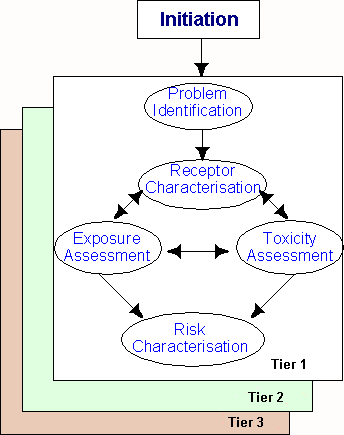|
Limitations of risk assessment What are RA tiers?
|
Risk assessment can be undertaken at three distinct levels of detail. At each tier, the five key tasks:
are undertaken to provide information and data in order to make a risk management decision or to decide whether it is necessary to proceed to the next level of detail. Broadly, the degree of detail and quality of the data at each level can be described as:
This tiered approach provides a systematic way of determining what level of investigation is appropriate for the site of concern, minimising unnecessary investigations, and allowing more efficient use of resources. It has been selected as the most appropriate model for risk assessment in New Zealand. USEPA risk assessment methods do not explicitly provide a tiered approach but leave the decision to risk assessors. However, in New Zealand we believe that few risk assessments require the level of detail described in some US models. The Canadian and Australian models do provide for a tiered approach and, to allow for the range of site sizes and complexity commonly found in New Zealand, a tiered model is considered the most appropriate method of working through a risk assessment. IterationsThe tiered model, however, does not preclude the requirement for iterations within each tier where necessary. Iteration is an 'unprescribed re-evaluation of information that may occur at any time during a risk assessment … done in response to an identified need, new information or questions raised during an assessment. As such iteration is a normal characteristic of risk assessments but is not a formal planned step' (USEPA 1998). An example of an iteration may be returning to sample uncontaminated land surrounding the site in order to answer questions about background concentrations of contaminants. While using a tiered RA model may reduce the need for iteration, it is not intended to eliminate it entirely, as iteration is an essential method of identifying and obtaining the information required. It is important to note that by proceeding from Tier 1 to Tiers 2 and 3, there is a decreasing degree of conservatism and an increasing degree of certainty that the values reached approximate the true values.
Tier 1 Risk AssessmentThe Tier 1 RA is intended to be a qualitative screening process. At this tier, the collation of information either through literature review or site investigation should be preliminary. The purpose of the Tier 1 RA is to determine two main points:
If the pathways are assessed as incomplete, or if contaminant concentrations do not exceed benchmark criteria for ecological or human health values, the RA process may be suspended without proceeding to Tier 2 assessment. A risk management decision may be made, based on the Risk Characterisation, to:
A Tier 1 RA assesses contaminants of concern against published assessment criteria (guideline values or benchmark criteria). These criteria have been developed to help the assessor undertake risk assessments and incorporate in one step many of the factors involved in receptor identification, and toxicity and exposure assessment. In developing these criteria, specific receptors have been identified, certain contaminant pathways have been assessed, and specific contaminants of concern are identified. These criteria can be either quite specific (e.g. maintenance worker exposure to benzene through inhalation). In other cases they can be general. For example, water quality guidelines for the protection of aquatic organisms provide protection to sensitive aquatic species, regardless of whether these receptors may actually be present in the receiving waters. We recommend that the assessor is familiar with the assumptions that are used to develop guideline values that are being used at a Tier 1 assessment. These are usually described in detail in the text accompanying the guideline values. Tier 2 Risk AssessmentThe Tier 2 RA is expected to be the most detailed level of RA undertaken for most sites in New Zealand. Tier 2 RA may involve more detailed site investigations if required, but is primarily intended to involve a more intensive literature search to modify the assumptions of the benchmark criteria used in Tier 1. The intention of this stage is to undertake a preliminary customisation of criteria for each contaminant specific to the pathways, receptors, media, and environmental conditions found at the site, and to establish modified assessment criteria. If the contaminant concentrations do not exceed the modified criteria, the RA process may be suspended without proceeding to Tier 3, and a ecological risk management decision made. Tier 3 Risk AssessmentFew NZ sites may be large or complex enough to justify the level of detail and investigation required for a Tier 3 RA. A Tier 3 RA will involve the development of complex models supported by further intensive site investigations of the contaminants of concern, pathways, and receptors characteristics. The intention of this tier is to further customise the modified criteria values calculated in Tier 2 to achieve a more accurate representation of the risk posed by the contaminants to specific receptors. The risk management decision may involve remediation or further iterations and will be made based on the Tier 3 Risk Characterisation of the site.
Introductory risk assessment is a Tier 1 activity. Advanced risk assessment is a Tier 2 & 3 activity. |
![]()
